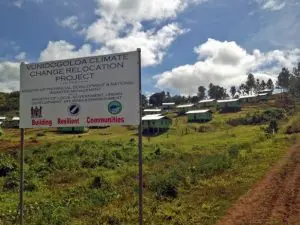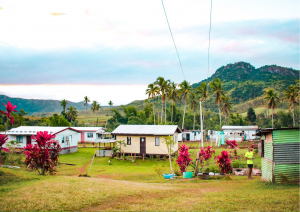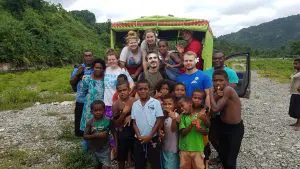Cyclone Winston would affect the lives of Fijians for years to come. I observed this first hand whilst volunteering with Think Pacific in January 2017. Nearly a year on, the damage from Winston still reverberated through the lives of my Fijian hosts in the small village of Saliandrau, nestled in the heart of the Namosi highlands.

The final night of my time in Saliandrau. A farewell feast in the new village hall, not yet fully constructed after cyclone Winston destroyed the original building that had served the village for decades. A stark reminder of the long-lasting effects of natural disasters, and now climate change, on the lives of individuals in the heart of the Pacific Islands
What does the future hold?
Recent evidence suggests tropical storms formed over warmer waters will be stronger and stay over land longer, increasing the devastation they cause. Models also suggest that whilst the overall frequency of tropical storms will decrease, frequency of category four and five storms could double in a warmer climate, increasing the incidence of events like Winston.
Beyond the increased physical destruction climate change will bring, a wide range of factors lead to distinct human health risks both during and after these extreme events. Rodents are driven from their burrows. Swamps form breeding grounds for mosquitoes. The risk of communicable diseases dramatically rises. In a climate change context this is particular worrying. A warmer climate will extend the geographical range over which many disease-carrying microorganisms can thrive as evident in the emergence of Zika and Chikungunya viruses in Fiji in 2015. Extreme precipitation has also been linked to an increase in gastrointestinal-related hospital admissions, posing further threat. These increasing climate change- related health challenges threaten Pacific healthcare systems already burdened by unprecedented levels of non-communicable diseases and health inequity with the rest of the world.

Beyond the physical impacts and the lasting health consequences of climate change, there is a further, more nuanced impact. Direct and indirect impacts of climate change across short, medium and long timeframes have been shown to have detrimental effects on mental health. This is compounded by the increased exposed to direct physical impacts and health inequity described above. With a pre-existing lack of mental health resources in the region, a climate change induced mental health pandemic could be on the horizon for the Pacific Islands.
It is without question that the Pacific Islands face a grave challenge in dealing with the direct and indirect consequences of climate change. These people live the reality of a fossil fuel centric world. A failure to curb emissions isn’t a number in a spreadsheet for them, its their homes, their lives and their children’s future. The threats they face should be a lesson to the rest of the world.
Climate change is real, climate change can destroy entire communities and climate change is not always fair. The Pacific Island nations, who have contributed unimaginably little to this crisis, may well be the people who lose the most.

Blog written by Ollie Short – Think Pacific Volunteer
Vinaka vakalevu Ollie for writing such an eye-opening article on climate change in the Pacific and your first hand experience of it.
Hopefully reading this blog may have inspired you to consider your own contributions to climate change, but more importantly – how these contributions could be lessened. Remember, everyone has the power to make a difference, reduce their carbon footprint and become more sustainable. Collectively, small individual changes collate and it is together we have the power to positively change the lives of people around the world. Everyone on this planet will be impacted by climate change in some shape or form – do you want to be part of the solution?




